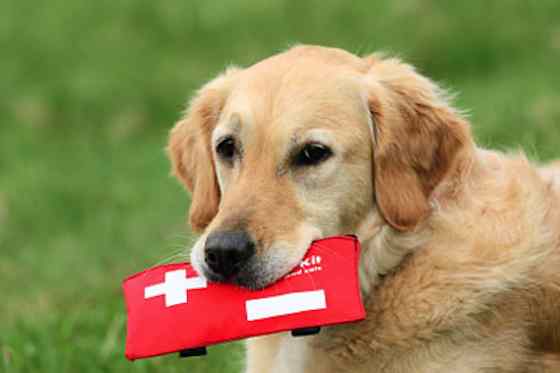- MENU
- HOME
- SEARCH
- WORLD
- MAIN
- AFRICA
- ASIA
- BALKANS
- EUROPE
- LATIN AMERICA
- MIDDLE EAST
- United Kingdom
- United States
- Argentina
- Australia
- Austria
- Benelux
- Brazil
- Canada
- China
- France
- Germany
- Greece
- Hungary
- India
- Indonesia
- Ireland
- Israel
- Italy
- Japan
- Korea
- Mexico
- New Zealand
- Pakistan
- Philippines
- Poland
- Russia
- South Africa
- Spain
- Taiwan
- Turkey
- USA
- BUSINESS
- WEALTH
- STOCKS
- TECH
- HEALTH
- LIFESTYLE
- ENTERTAINMENT
- SPORTS
- RSS
- iHaveNet.com: Pets
by Dr. Tracy Dewhirst

The Boy Scout motto "Be prepared" is quite true for animals as well as people. Accidents never occur just after you've read the CPR handout or reviewed the pamphlet on hemostasis (stopping bleeding). Having a properly stocked first aid kit, along with mental preparedness to make split-second decisions, can definitely change the overall outcome if your dog has an emergency.
Understanding how and when to use each item in a first aid kit is just as important as the kit itself. Here's my list of must-have items, along with some tips:
Wound cleanser.
Use mild soap and warm water, or cleansers such as Betadine and chlorhexidine rinse. Hydrogen peroxide is fine for the initial cleaning but not for repeated use. Avoid alcohol because it burns.
Antibiotic ointment.
Use on a cleaned wound before bandaging.
Small and large gauze pads.
Necessary for applying pressure to a bleeding wound. Also used as the primary layer of a bandage.
Elastikon.
The outer layer of the bandage that keeps the gauze in place. Do not wrap bandages tightly. Instinct tells us to wrap a bandage snugly to reduce further bleeding or prevent slipping, but a tight bandage can actually cut off the blood supply. Make sure you can comfortably slide your pinky finger under the wrap.
Long strips of old T-shirt or cotton dressings.
These come in handy as bandage material or as an emergency muzzle. The temperament of your dog can change when she is in pain or feels threatened. Before attempting to move or touch an injured animal, make sure the dog is not displaying signs of aggression, such as snarling or growling. Use a muzzle if there is any chance the injured dog might snap.
To make a muzzle, tie a loop in the cotton strip, place it over your dog's snout with the knot on the upper side, tighten, wrap the strap around the snout again (ending on the underside) and then tie behind the ears. Here's a good demonstration of emergency muzzling:
Hydrogen peroxide.
Use to induce vomiting. Contact your veterinarian before doing this; some materials are more harmful if vomited.
Phone numbers.
Keep a record of your veterinarian's or emergency clinic's contact information, as well as the animal poison control hotline number at 888-426-4435.
Scissors, sunscreen, eyewash, snakebite kit and cold packs.
These should be included in a complete pack.
Duct tape. Useful for protecting footpads and covering gauze on minor lacerations if a cotton wrap won't hold.
Benadryl.
Useful for motion sickness and insect bites. Ask your veterinarian for an appropriate dose for your dog.
Never use acetaminophen or ibuprofen. For minor pain relief only, use drugs that are prescribed by a veterinarian.
Prepared first aid kits are also available in pet stores and online if you don't want to assemble your own.
Be Cautious
I cannot stress enough how important it is to use caution when giving first aid to your pet. Have someone restrain your dog to avoid bites and scratches. Even a gentle dog can nip when in pain, or if he's feeling frightened or traumatized. Muzzles and restraint help prevent accidents that might require your own first aid treatment.
Photo: @iStockphoto.com/PK-Photos
AUTOS | HOBBIES | EDUCATION | FAMILY | FASHION | FOOD & RECIPES | HOME DECOR | RELATIONSHIPS | PARENTING | PETS | TRAVEL | WOMEN
PET STORIES and PET ARTICLES ...
- Is Your Dog Cut out for Field Trials?
- Should You Crate-train Your Puppy?
- How to Play Soccer With Your Dog
- The Best Way for Your Dog to Ride in the Car with You
- Good Dog Park Etiquette
- What Is Freestyle Dancing With Dogs?
- Canicross: An Easier Way to Run With Your Dog
- Reading Your Dog's Body Language
- Kitten Kindergarten
- Tips to Keep Your Dog Safe While Flying
- Keep Your Dog Warm in the Winter
- Scottish Deerhound: The Ideal Exercise Buddy
- Teach Your Dog to Fetch
- Is Your Dog Bored?
- 7 Ways to Pamper Your Cat
- The Best Games to Play With Your High-Energy Dog
- Dog Feeding Mishaps Corrected
- How to Succeed at Off-Leash Dog Play
- ID Your Relationship With Your Cat
- Photographing Your Elusive Feline
- How to Keep Your Pet Safe During the Holidays
- When Good Dogs Turn Bad
- From Finicky Fido to Chowhound Charlie
- Insure Your Kitty's Health
- Unconditional Love: My Cat Forgives Me Every Day
- From Feline to Family Member
- Is Water From a Christmas Tree Stand Harmful to Cats?
- A Day in the Life of a Sheepherding Dog
- Go on a Desert Retreat With Your Dog
- Dog Food Goes Natural and Holistic
- Determining a Food Allergy
- Exercise Gone to the Dogs
- Find the Right Sport for Your Dog
- Make Your Dog a Part of Your Wedding
- Hydrotherapy Helps Dogs Get in Shape
- How Your Cat Says 'I Love You'
- Lost Cats Found
- De-stress Veterinary Visits for Your Cat
- Keeping Cat Food Fresh
- Second-Hand Cat, First-Rate Pet
Copyright ©
Pets | Dogs: Is Your Dog's First Aid Kit Complete?